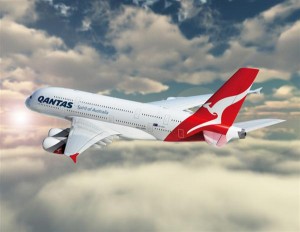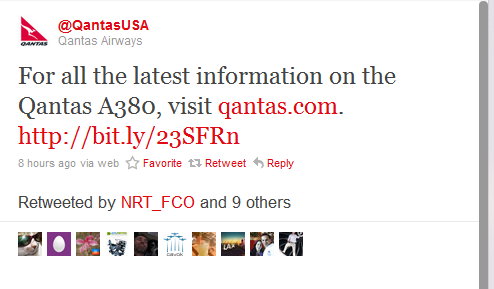
 Yesterday’s emergency landing of a Qantas Airline A380 Airbus in Singapore provided a perfect opportunity for the company to utilize social media to get their official message to the public quickly and effectively. Unfortunately, they did no such thing.
Yesterday’s emergency landing of a Qantas Airline A380 Airbus in Singapore provided a perfect opportunity for the company to utilize social media to get their official message to the public quickly and effectively. Unfortunately, they did no such thing.
Passengers were quick to distribute pictures, messages, and video around the Web after the Sydney-bound plane’s engine exploded, causing the aircraft to return to Singapore.
Twitter was a-buzz with rumours of the incident yesterday, as many reported the plane had crashed on the Indonesian island of Batam. In fact, metal fragments from the engine fell onto the island, hitting houses, a car, and a classroom full of children, reports the Age. Without an official statement from Qantas, however, the Internet went into a frenzy as incorrect assumptions of a crash and photos of the damaged engine abounded.
Qantas runs an official Twitter account, @qftravelinsider, offering tips for travellers. A regularly occurring message from the account was posted again yesterday in answer to queries about the A380 incident.

Another account run by the airline, @qantasusa, offered an update early this morning (Australian EST) directing queries to their official statement.

Whilst these measures are important, and Qantas deserves props for getting the information out there, the time it took for an official statement to surface led to wild rumours running rife, and worried families getting the wrong information. We’ve seen evidence before of breaking news developing on Twitter, and it’s about time companies realized they need to use social media in an instance like this to keep their brand in-tact, and keep customers informed.
Although the backlash may not extend to sales loss or a court case, this is an obvious example of a company misunderstanding how to use social media tools effectively, and the benefits they can bring. Nestle’s palm-oil disaster earlier this year is another example of customers overwhelming a company when it comes to social media, and how a slow response can be damaging for the brand. According to Tony at Igloo, Nestle even tried to remove the incriminating video posted by Greenpeace, and deleted negative comments from their Facebook page.
On the other hand, companies like Comcast and even Domino’s are making a name for themselves as companies that listen, care, and most importantly, respond. This post explains how Comcast has replied promptly to customer feedback via Twitter in the past, improving on their notably lacking customer service standard. Domino’s took a different approach, using video to apologize for an embarrassing employee stunt. Hopefully Qantas will learn from this experience and be first with the news next time an incident like this threatens their image.
Get the TNW newsletter
Get the most important tech news in your inbox each week.





